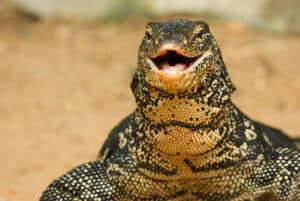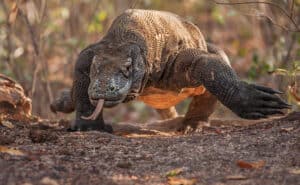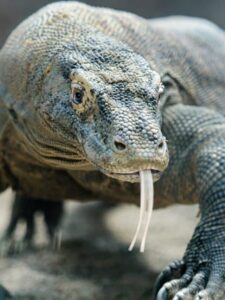Continue reading for our analysis...
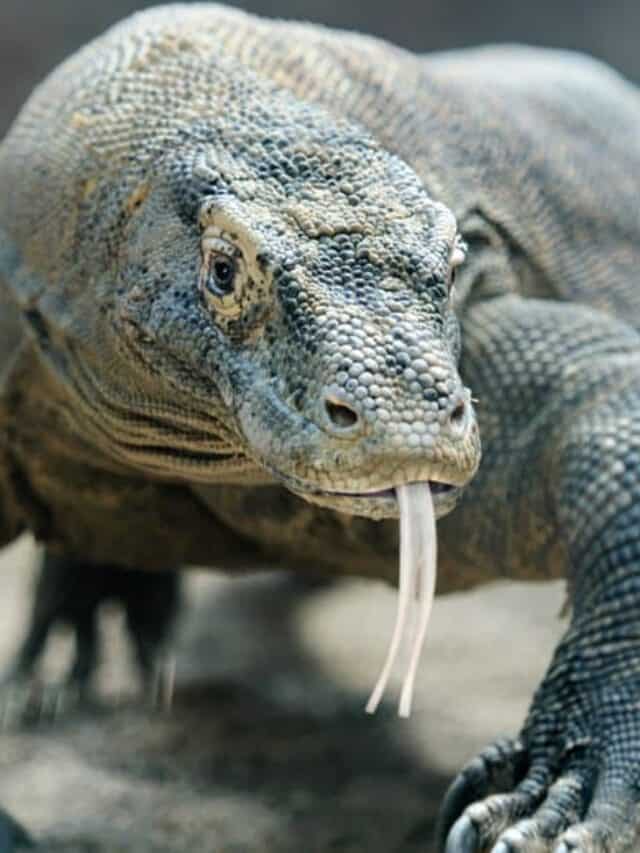
Komodo dragons are large lizards with stout limbs, strong and nimble necks, and long tails. They also have forked tongues that appear to be yellow. Youngsters may have a more colorful color and pattern than adults, which have prominent, big scales that are nearly uniform in color.
The Komodo dragon can devour enormous portions of meat with amazing speed thanks to its powerful jaw and throat muscles. The lower jaw opens extraordinarily wide thanks to several movable joints, including the intramandibular hinge.
An adult may readily take up to 80% of their own body weight in a single meal thanks to the stomach’s easy expansion, which most certainly explains some tall tales of enormous weights in captured people. Komodos have the ability to vomit their stomach contents when they feel threatened in order to reduce their size and run away.
Komodo Dragons Can Grow Very Large
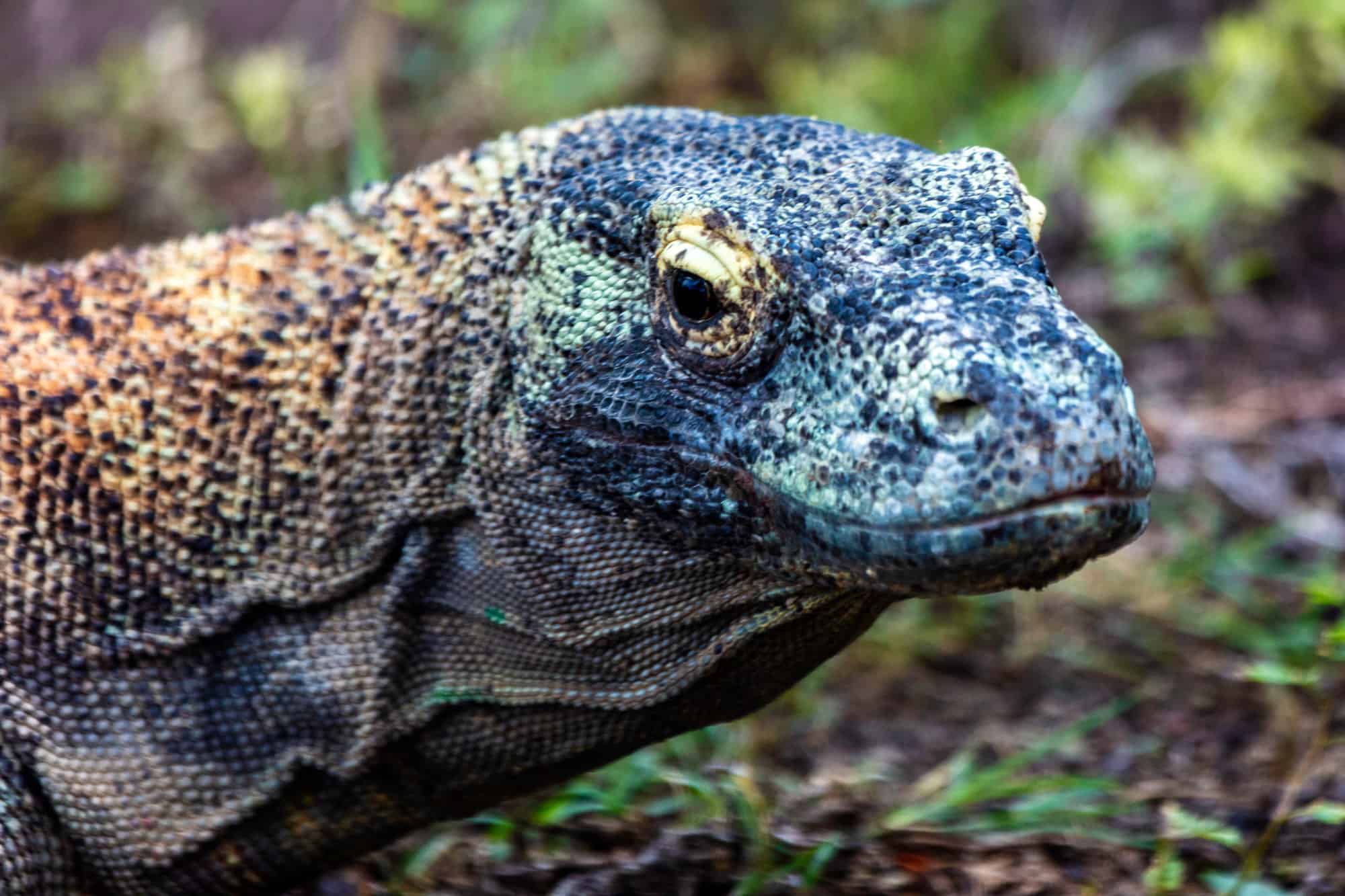
Komodo dragons can eat large portions in one sitting due to their strong jaws and throat muscles.
©iStock.com/desertsolitaire
The largest confirmed specimen was 10.3 feet in length and weighed 366 pounds, while the average weight of these wild dragons is around 154 pounds. Men often develop larger, heavier bodies than females. Almost every form of meat is consumed by Komodo dragons, which scavenge for dead animals or stalk prey ranging in size from tiny mice to massive water buffalo.
Young consume mostly insects, tiny reptiles, and birds, as well as slithering snakes. If they survive to age five, they transition to larger prey such rats, monkeys, sheep, wild boars, and their favorite – deer! These reptiles are cannibalistic and tertiary hunters at the pinnacle of their food chain.
An Easy Lunch
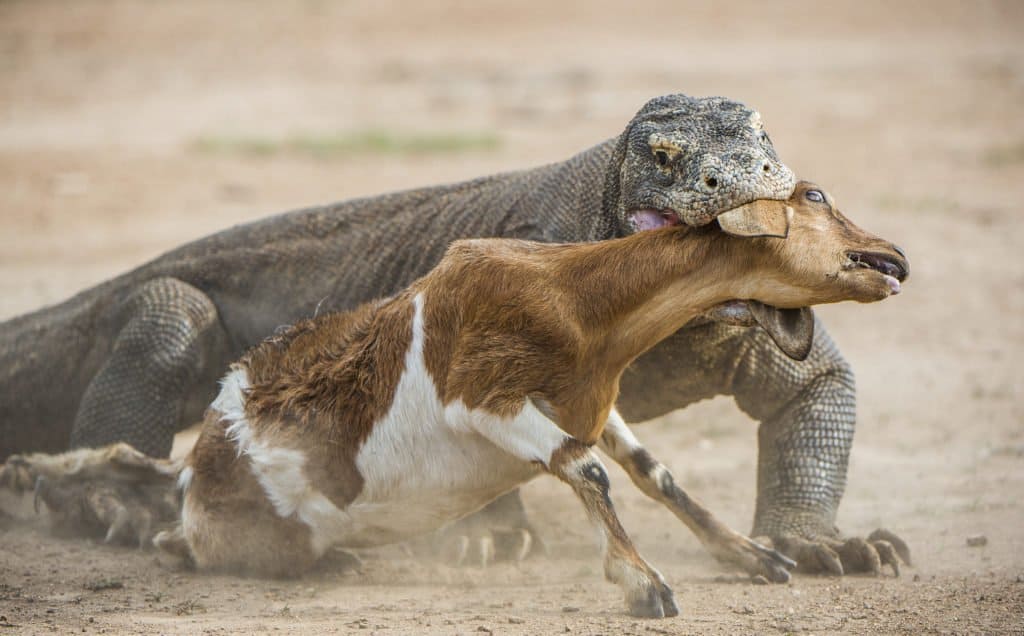
Komodo dragons can take down large animals like livestock.
©Sergey Uryadnikov/Shutterstock.com
Footage of a giant Komodo dragon walking along a river bank gives us an incredible view of just how massive these creatures are. As it treks along, this lizard is looking for a tasty snack. It spots an unfortunate fish that seemingly died after getting stuck in between rocks.
Although the dragon doesn’t know if it’s safe to eat this dead fish, it gobbles the sushi right up! Adjusting the fish so it’s head first, the Komodo dragon swallows it whole! The major food detector for the Komodo dragon is its sense of smell. It sniffs the air with the help of its long, yellow, forked tongue.
The tongue’s forked tip is then moved to the mouth’s roof, where it interacts with the Jacobson’s organs. These chemical detectors can detect airborne chemicals, which allows them to “smell” prey like deer. The Komodo dragon may tell an animal is moving from the right if there are more molecules concentrated on the right tip of the tongue than the left.
The dragon uses this technique, together with an undulating gait in which the head moves from side to side, to detect the presence and movement of food. Sometimes these reptiles can detect the smell of carrion or a rotting carcass nearly three miles away.
Approximately 12% of their prey is wasted by Komodo dragons, making them efficient eaters. Other animals leave behind much more of an animal and let it go to waste.
Is It Normal For A Komodo Dragon To Swallow a Fish Whole?
The keyword in the question, “Is it normal for a Komodo dragon to swallow a fish whole?” is “fish.” Generally, if the animal is not too large, a Komodo dragon can and will swallow it whole. Given that the Komodo dragon has special tools in its jaws like an intramandibular hinge which can make its jaw open very wide, as well as movable joints, it has no problem swallowing a fish like the one in the video or even an animal that doesn’t go down so smoothly. For example, there is footage of a Komodo dragon swallowing a rather large seagull whole, feathers and all. It’s able to regurgitate parts of the animal that its stomach would struggle to digest, including horns, teeth, hair, and feathers.
Back to the operative word “fish.” Truth be told, Komodo dragons don’t typically eat fish. They are not the most agile fishermen. Young Komodo dragons typically consume small lizards, insects, birds, and snakes, while their adult counterparts target larger prey like rodents, monkeys, goats, wild boars, and even deer. Komodo dragons will also prey on each other in some cases.
As fish are not part of a Komodo dragon’s typical diet, we’d surmise that it is not normal for a Komodo dragon to swallow a fish whole. But swallowing the right-sized prey whole is completely normal.
Thank you for reading! Have some feedback for us? Contact the AZ Animals editorial team.



